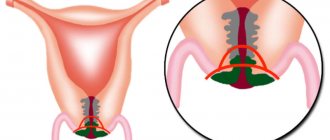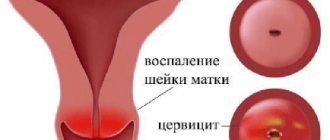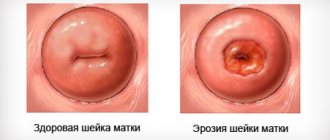The main cause of the pathology is a change in the microflora of the mucous membranes from negative internal and external factors. Erosion is a benign formation and is a lesion (wound) on the surface of the reproductive organ or cervical canal. If not treated in a timely manner, it can be complicated by oncology and other dangerous diseases. Let's consider discharge during cervical erosion as the main sign of a disorder.
Cervical erosion and discharge
The nature of a woman’s discharge can tell a gynecologist a lot. It will also force the woman to immediately seek help.
Often, discharge from erosion is not particularly different from normal everyday discharge. Only an increased amount can indicate that something is wrong in the body.
Also, after sexual intercourse, the discharge is streaked with brown color, but some attribute this manifestation to a stormy night. But if the discharge does not look like scarlet blood, then there is a reason to visit a doctor.
Discharge color
Some women begin to experience brownish discharge a couple of days before their period. They assume that this is the beginning of the menstrual cycle and manifests itself this way. But often this is not the case. Such discharge indicates that an inflammatory process may occur in the uterus, which will subsequently affect the ovaries.
There is also a white, curd-like discharge. This is characterized by the presence of fungus in the uterine cavity. Before starting treatment, you need to give the body time to overcome this problem. And then treat the damaged uterine tissue.
Along with erosion, some patients experienced a disease such as ureaplasmosis. It is characterized by the presence of yellowish discharge. This will require treatment of the underlying problem and the current one.
Discharge after treatment
After treating erosion, some patients do not notice much improvement. The discharge remains the same, only the amount has changed, and not significantly. This suggests that the woman, in addition to this pathology, also has ongoing gynecological diseases that need to be urgently treated.
Important: Erosion is not cured overnight; it can occur after some time. Therefore, treatment requires a long time.
Mostly ladies find discharge in general unpleasant. They are constantly trying to get rid of them by frequently washing and douching. Clinic doctors strongly do not recommend doing this. Due to frequent hygiene procedures, beneficial microorganisms are washed out into the vagina, which protect the mucous membrane from adverse effects.
Erosion to the touch
In the normal state, representatives of the fair sex have vaginal discharge. They depend on the day of the cycle and the presence of infections. Typically, they are colorless, with a neutral odor and traces of mucus. They do not cause any unpleasant sensations. What kind of discharge occurs during erosion?
The most common type of discharge with this disease is brown or brownish discharge. In color they can resemble strong tea. And they usually appear after sex or before menstruation.
Often, women associate them either with too intense sex, or with the approaching period and do not attach any importance. This hidden danger can have consequences.
The most difficult among them is the degeneration of erosion into oncology. If after intimate relations the blood is not bright, but brown, you most likely have erosion. Or if brown discharge appears spontaneously, you most likely have a damaged cervix.
Discharge after cauterization of erosion
After cauterization of cervical erosion, a special protective film is formed at the wound site. It is called a scab. A film in the form of a thin skin protects the wound from infections and viruses.
After 14-16 days, it begins to break down and be released from the uterus in the form of bloody discharge. It is not recommended for a woman to:
- Have sex and exercise;
- lift weights.
It is necessary that the uterine mucosa is completely renewed and acquires a healthy appearance.
If cauterization occurs in the middle of the cycle or before menstruation, then the volume of their discharge can be very large. Basically, this procedure is carried out after critical days, so during the normal course of the rehabilitation period there cannot be any discharge.
If you experience spotting similar to your period, you need to see a doctor to get medical help.
Damage to a scab or the onset of menstruation is a reason to contact a doctor. Only they can stop the bleeding and prescribe appropriate treatment.
Protracted erosion process
Severe bleeding may be a sign of a large area of erosion, which affects the vessels of the epithelium. In this case, the process destroys the tissue in depth. This condition is characterized by pronounced symptoms, since the nerve endings in the thickness of the mucous membrane of the cervix are affected:
- sharp pain in the lower abdomen
- frequent bleeding of varying intensity.
In this case, postponing a visit to the gynecologist is life-threatening. A protracted process requires radical treatment in the form of cauterization. You should not refuse it - in many cases it saves you from a serious complication in the form of oncology.
Based on the diagnostic results, the doctor will prescribe modern treatment, for example, cryodestruction. This method is used to influence the extensive process of erosion. It should be noted that after cryodestruction there will also be a slight discharge of blood. They are not associated with the course of the disease, but are a symptom of wound healing. In addition to cryodestruction, laser therapy can be used. It is characterized by less blood secretion, sometimes by its absence.
Explanation about cervical erosion
The terminology “erosion” means the presence of cracks in the intact lining of the uterus. The normal appearance of the cervix is a complete epithelium, consisting of several layers, without visible damage.
In general, cervical erosion is a disease that does not pose any visible threat to the body and reproductive system of a woman. It is a benign formation that rarely leads to serious pathologies. But it needs to be treated in order to avoid the manifestation of unpleasant symptoms.
This disease is divided into several varieties. These include:
- Congenital erosion. This pathology is a displacement of the cervical columnar epithelium. Doesn't show itself at all. Diagnosed in little girls and teenagers. Treatment is not required, since the disease does not progress to the malignant stage.
- True erosion - manifests itself in the form of a small rounded area of red color, sometimes bleeding. True erosion lasts up to 14 days, after which it becomes covered with cells from neighboring tissues.
- After true erosion, the next stage begins - pseudo-erosion. It is characterized by the presence of a rounded red area, but can reach several centimeters in diameter. It can also be covered with a purulent film. This type of erosion must be treated to prevent complications.
Often, only during a gynecological examination does a woman learn about the presence of this disease.
Mechanical damage to cells
The mechanical effect on the cervix affected by erosion also causes discharge mixed with blood. These include:
- rough sexual intercourse
— incorrect insertion of a hygienic tampon
— damage due to the installation of a fallopian device.
In addition, erosion can bleed after medical procedures requiring dilation of the cervix. Such procedures include:
- examination by a gynecologist
- diagnosis using hysterography.
The delicate epithelium of the organ, damaged by erosion, can bleed from just touching it. The discharge in such cases will be brown, sometimes pink. If infection has occurred, they will be brown, and if the process goes deep into the epithelium, they will be red. Such conditions require urgent treatment if there are no symptoms of third-party diseases. If they exist, a comprehensive diagnosis is carried out and an optimal treatment regimen is prescribed.
Signs and causes of appearance
Many female gynecological diseases of the genital organs have the same cause and symptoms. The manifestation of symptoms begins small, and if you do not pay attention to them, they progress to stages at which a lot of effort is required for treatment.
Causes of erosion
Cervical erosion can arise out of nowhere, but often a number of reasons lead to this. The most famous and widespread of them are:
- frequent change of partners;
- abortions;
- early sexual life;
- genital herpes;
- HPV – human papillomavirus;
- infectious diseases of the genital organs;
- weak immunity;
- hormonal disorders.
More common causes include mechanical injuries to the cervix that occur during difficult childbirth or abortion. Also with long-term use of intrauterine and hormonal contraceptives.
Signs and symptoms
The presence of any symptoms that are incomprehensible and unfamiliar to the body indicates that a woman should definitely visit a gynecologist. Cervical erosion generally does not manifest itself in any way. But there are several signs that should not be ignored:
- bleeding after sex;
- pain when urinating;
- changed character of leucorrhoea;
- purulent discharge with an unpleasant consistency and odor.
Often a woman confuses the symptoms with some other diseases, but a gynecologist during an examination can accurately tell the nature of the disease.
How to recognize whether true or pseudo-erosion is bleeding
To accurately diagnose an erosive lesion, a number of known factors are used:
- bleeding erosion does not depend on the menstrual cycle. The discharge is chaotic;
- the discharge is most often brown in color, sometimes with an admixture of ichor;
- With mechanical irritation of the mucous membrane, heavy bleeding may occur, which does not last long and stops on its own.
If the clinical picture of the pathology differs from the indicated points (bleeding does not stop for a long time, is accompanied by pain/discomfort, has an unpleasant odor), this may mean either uterine bleeding or the manifestation of other gynecological diseases (even oncology).
To clarify the situation, colposcopy is prescribed , which will describe in detail the condition of the mucous membrane of the uterine pharynx and help establish the correct diagnosis.
The cervix plays an important functional role. There are special glands here that produce lubricant for the external genitalia. At the same time, mucus prevents infection from entering the uterine cavity. Most often, a woman does not even suspect that she has a disease associated with damage to the mucous membrane of the cervix. Slight bleeding sometimes with cervical erosion is almost the only sign indicating the presence of pathology. Leucorrhoea of another type indicates the addition of concomitant diseases.
Diagnostics
When a woman comes for a gynecological examination, the doctor can use a special mirror to detect erosion. It is reddish in appearance and may bleed slightly when pressed. Its surface is velvety or whitish.
Colposcopy is an examination of the cervix under a microscope. If the doctor has any doubts or he doesn’t particularly like the appearance of the erosion, he performs an extended colposcopy. It is carried out using special coloring solutions.
The following methods are also used for extended research:
- cytological examination;
- biopsy.
Cytological examination is the process of scraping cells from the affected part. Then, using high magnification, he looks around.
A biopsy is performed by pinching off a piece of tissue from the sore spot and further examining it under a microscope. Using this method, you can detect not only the stages of erosion, but also the formation of a malignant tumor.
If, during the examination, the doctor told the patient that she had developed erosion, and also revealed a predisposition to transition to a more complex formation, the woman needs urgent treatment.
How to identify erosion yourself
Erosion is characterized by an asymptomatic course for a long time. If the cause of erosion is mechanical damage to the mucous membranes, the likelihood of a characteristic clinical picture appearing is minimal. Symptoms can be traced against the background of the addition of viral activity. A woman notices a deterioration in her health, possibly the appearance of pain and discomfort, menstrual irregularities and the appearance of bleeding not related to menstruation.
Attention! If you notice any changes in your own health, you should consult a doctor. Trying to diagnose and treat pathology at home is not recommended.
Examination by a gynecologist
The following diagnostic techniques will help to clarify the diagnosis and, based on it, select the necessary treatment:
- biopsy – allows to exclude the possibility of developing a malignant process;
- gynecological examination of the vagina in the speculum;
- flora smear;
- analysis for hepatitis, HIV and syphilis;
- cytological examination;
- testing for sexually transmitted infections;
- Ultrasound of the pelvic organs;
- general blood and urine analysis.
Colposcopy helps determine erosion. If a lesion is suspected, an extended technique is used. The principle of the study is that special solutions (weakly concentrated acetic acid and an iodine-containing component) are applied to the woman’s cervix. After processing, the changes that appear are examined using an optical device. In the presence of an erosive defect, there are atypical areas in the area where solutions are applied; they do not turn brown, the color characteristic of iodine, unlike healthy tissues. After confirmation of the diagnosis, a treatment regimen is determined.
Treatment
There are several ways to treat cervical erosion.
- Conservative treatment is a method of applying chemicals to the lesion. These medications are often used - vagotil or solkovagin. A tampon is soaked in it and injected into the woman. This remedy acts on destroyed cells and destroys them. This is how healing occurs. This method of treatment does not have negative consequences either on neighboring organs or on the body as a whole.
- Application of the diathermocoagulation method (cauterization). This is the effect of electric current on erosion. The procedure takes 15 minutes, but pain is possible after it. This is a fairly common method due to its low cost. Applicable only to women who have given birth.
- Treatment with liquid nitrogen is popular. It freezes diseased cells, and subsequently they completely die without leaving scars. A fairly safe method, but treatment is carried out mainly in private clinics.
- Treatment with laser.
- Surgery is used only if there is an unfavorable prognosis or a severely advanced case. Strictly not recommended for nulliparous women.
- Traditional treatment. Herbal medicine has always been used by people, but it must be used with caution. A well-known method of folk treatment is treatment with sea buckthorn oil. A tampon is impregnated with it and injected inside. Calendula tincture is also used for douching.
But before undergoing any of these types of treatment, a woman needs to pass all tests and undergo a medical examination. Also exclude the presence of sexually transmitted infections.
Traditional medicine
To treat discharge in folk medicine, anti-inflammatory and wound healing agents are used (most often sea buckthorn oil and honey). To do this, a tampon soaked in honey or sea buckthorn oil is inserted into the vagina at night (it is not used for ectopia). You can use honey candles made from solid honey.
You can eliminate discharge by douching with decoctions of medicinal herbs - St. John's wort, marigold, sage, chamomile. For discharge, medicinal plants (calendula and thuja) are also used. In addition, for profuse vaginal leucorrhea (yellow or mixed with blood), homeopaths prescribe metallic silver in the form of Argentum metallicum or Argentum nitricum (silver nitrate).
Cervical erosion and pregnancy
Cervical erosion is not a dangerous disease for either the expectant mother or the child. The main thing is that the woman does not have other gynecological diseases:
- HPV;
- gonorrhea;
- chlamydia;
- herpes.
If they are present in a pregnant woman, then treatment must be carried out before delivery, because these diseases, along with erosion, can cause miscarriage or termination of pregnancy.
If the test results are negative for viral diseases, treatment is postponed until the woman gives birth. In the pregnant woman’s chart, the doctor must describe that the patient has erosion. Obstetricians during childbirth should be aware of this type of information.
When delaying treatment is impossible, the doctor decides on urgent treatment. The pregnant woman is prescribed medication or special lotions.
After the woman gives birth, both the body and the uterus are completely restored, erosion should be treated in any case. During childbirth, the uterus can be damaged and due to this, the disease can subsequently progress. Any method may be suitable for treatment.
Diagnosis and treatment of pathology
Treatment of discharge due to changes in the cervix is carried out after a comprehensive diagnosis, which includes:
- examination on a gynecological chair;
- transvaginal ultrasound;
- Analysis of urine;
- UAC;
- biopsy followed by samples of suspicious tissue in the laboratory;
- blood testing for HIV and other sexually transmitted diseases;
- colposcopy for a more accurate study of the affected areas of the mucous membranes.
The disorder is treated in several ways:
- medicinally;
- surgically;
- using traditional medicine.
During pregnancy, relief of pathological signs occurs with medication. For this purpose, vaginal suppositories with anti-inflammatory and antimicrobial therapeutic effects are used. According to comments from women on the Internet, the most effective suppositories for the treatment of cervical erosion are Betadine, Polygynax and Hexicon.
To treat large erosions, surgical methods are used:
- laser therapy;
- cryodestruction;
- chemical cauterization.
During the recovery process, specific discharge may appear after cauterization of the erosion. Find out more about them by going to one of our articles.
With the help of traditional medicine, you can only eliminate discharge during illness. It will not be possible to eliminate the cause of damage and inflammation of the mucous membranes. Non-traditional remedies in gynecology are used to consolidate the results of drug and surgical therapy.
Good results in the fight against pathological discharge can be achieved by douching and baths based on medicinal herbs: sage, chamomile and St. John's wort. For the same purpose, sea buckthorn oil is used, which stimulates the rapid regeneration of damaged mucous membranes of the cervix.
Cervical erosion is asymptomatic for a long time. A developing disorder can be identified only by a change in the color of the secretion released from the genital tract. With small ulcers, the color of the mucus turns brown or yellowish due to the fact that a meager amount of blood tints the secretion. Extensive and deep erosions bleed heavily after mechanical damage (use of a tampon, suppositories, sexual intercourse). The discharge may be pinkish or bright red in color. Bright yellow and green leucorrhoea is a sign that, against the background of erosion, acute inflammatory processes are developing in the organs of the reproductive system.
Nutrition for cervical erosion
After treating erosion, you must adhere to the following diet:
- vegetables;
- avocado;
- dairy products;
- rose hip;
- fatty fish;
- eggs;
- olive oil.
These are the basic foods that need to be included in your daily diet. They will help boost immunity and also keep the body in normal physical and active shape.
Along with these, it is necessary to completely exclude:
- mayonnaise;
- fast food;
- canned food;
- fast food.
These foods are contraindicated even in the absence of any diseases. They are the instigators of such pathologies as: cancer, erosion, stomach ulcers.
Consequences and prevention of erosions
Erosion is classified as a benign disease, but this does not mean that it does not need to be treated or that it will not harm the body.
If the erosion is large and neglected, then with each subsequent stage of formation it will sooner or later develop into cancer. It will also be a magnet for the formation of persistent infections in the genital tract. Such ongoing processes can prevent a woman from becoming a mother.
To avoid negative consequences, you need to visit a gynecologist twice a year. To undergo not only colposcopy, but also, if possible, to submit material for a biopsy. Treat all existing diseases.
Lead a correct lifestyle. Avoid frequent changes of partners, which damage the female vaginal environment. Avoid rough sex. Exercise.
Erosion is a disease that you don’t seem to feel, but it causes discomfort. Therefore, in order to avoid diseases, it is necessary to monitor your health. Many women have gone through the procedure of removing erosion. Some were cured after the first time, while others needed quite a lot of time. How did it go for you? Maybe there is someone who would like to share their secrets on how to combat erosion, and also give some tips and recommendations for treatment?
Video: cervical erosion, discharge in a pregnant woman
EROSION of the cervix, discharge in a pregnant woman - result in 2 weeks /AURORA / siluron juice / 2017
Video: cervical mucus. Cervix and its functions
Cervical mucus. The cervix and its functions.
What are they, what does it mean?
Not only blood on underwear can lead a woman to a gynecologist:
| Curd-like profuse leucorrhoea | Most often indicate a fungal infection in the body. We are talking about thrush, which can be eliminated with an antibacterial course of treatment. An inflammatory process may accompany candidiasis, as a result of which the leucorrhoea will be less curdled, but will become more abundant |
| Yellow discharge | This is how leucorrhoea is characterized by a yellowish tint (uniform/with lumps/odorless/with a sourish admixture). The reason for their appearance can be attributed to erosive lesions, if the examination also revealed pathogenic bacteria (staphylococcus, ureaplasma), changes in microflora, inflammatory processes of internal organs (adnexitis, salpingitis), concomitant sexually transmitted diseases, venereal diseases |
| Purulent/mucopurulent | Discharge of this nature indicates severe inflammation (vulvitis, vaginitis, purulent cervicitis) in tandem with a pathogenic infection (chlamydia trachomatis, mycoplasma genitalium) |
| Transparent profuse leucorrhoea | Most often observed at the final stage of treatment for erosion of the uterine pharynx, when the mucous membrane begins to regenerate |










